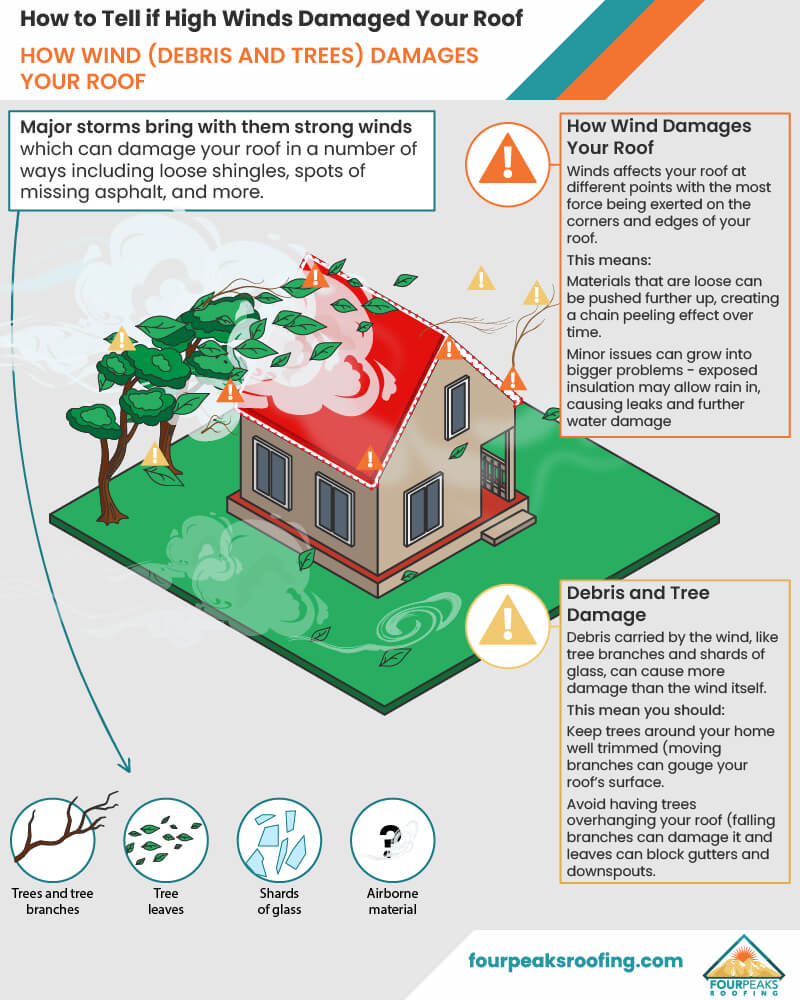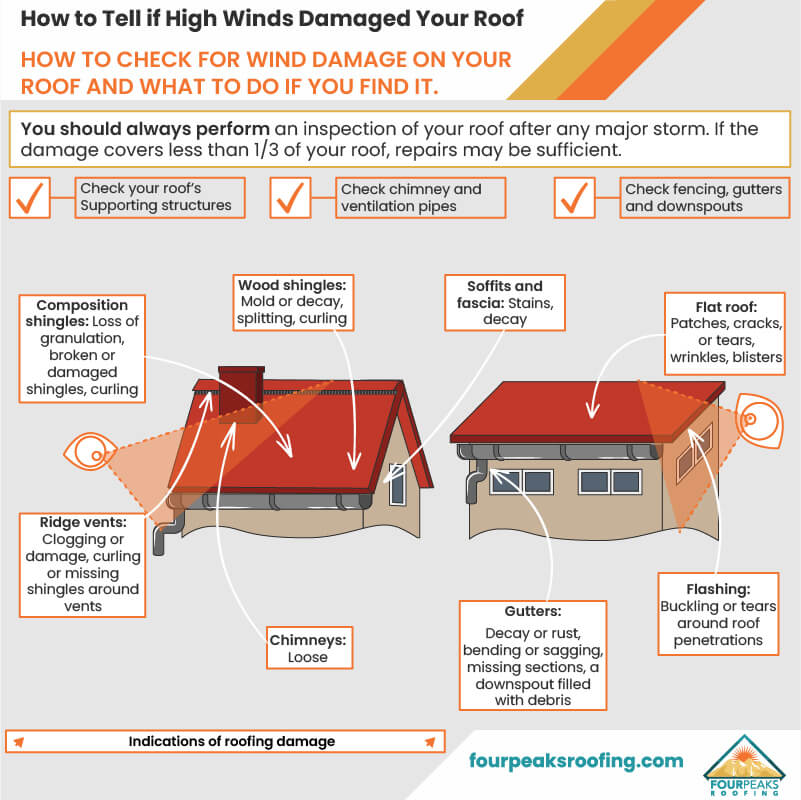If major storms have hit your area, you may notice roof damage when the sky clears and the sun shines. It’s possible the high winds that often accompany storms caused the damage, including loose shingles, spots of missing asphalt, and more. Wondering if the high wind damaged your roof? Here are some signs to look out for.
How Wind Damages Your Roof
The effect of wind moving over a roof is not uniform. The corners and perimeter of the roof are more vulnerable to high wind pressure than the center of your roof. According to the National Roofing Contractors Association, wind damage starts at the edge.[1]
If materials are loose at all, the wind can blow under them and push them up. This creates more space for wind to lift the materials, creating a chain peeling effect over time. Wind damage may begin with minor issues but will grow with repeated exposure to wind. If the insulation is exposed, rain can get in and may cause leaks or water damage in your home.
Debris and Tree Damage
Aside from direct wind effects on your roof, significant wind during storms can cause debris that can make its way to your roof. Tree branches, shards of glass, or other materials can hit your roof, which is often more damaging than the wind itself.
When you inspect your roof after a wind event, consider what may have blown onto it or across it. Check your gutters and downspouts for debris that may clog them and create more significant problems in the future.

You should always keep your trees trimmed and away from your roof. When branches touch a roof, they scratch and gouge the roofing materials when the tree moves in the wind. Falling branches can also damage your roof shingles or other materials.
How to Check for Wind Damage on Your Roof
Here’s how you can determine if the wind damaged your roof:[1]
Perform an Inspection
Inspect your roof and look for missing or damaged shingles, which may look curled, cracked or torn. If that damage only covers about a third of your roof, roofing repairs may be sufficient to correct them. More extensive damage may require a roof replacement.
You should also check supporting structures, such as the chimney, roof flashing, ventilation pipes, fencing, and gutters, all of which can be damaged by winds. Be sure to inspect these structures carefully.

Here are some indications of roof damage:
- Composition shingles: Loss of granulation, broken or damaged shingles, curling
- Wood shingles: Mold or decay, splitting, curling
- Flat roof: Patches, cracks, or tears, wrinkles, blisters
- Flashing: Buckling or tears around roof penetrations
- Soffits and fascia: Stains, decay
- Roofing cement: Excess cement or crumbling
- Ridge vents: Clogging or damage, curling or missing shingles around vents
- Gutters: Decay or rust, bending or sagging, missing sections, a downspout filled with debris
- Chimneys: Loose or missing flashing, damaged bricks, cracked joints, leaning
Inspect Your Interior
Even if your roof looks fine, you may notice signs of damage inside your home where wind damage creates an opening for rain or moisture to enter. Look for moisture marks and brown, yellow, or gray stains on the walls or ceilings, all of which can indicate roof leaks.
Another indication could be a sudden rise in your energy costs without an apparent cause. If your roof ventilation is compromised, you may lose some heat or air conditioning, driving your energy bills up.

What to Do if Your Roof Has Wind Damage
If you notice signs of roof damage from wind or flying debris, it’s important to correct it as soon as possible. The longer you wait to address the damage, the worse it will get. Roof repairs are less expensive when you catch them early, rather than waiting until you have interior leaks or other significant damage.
Contact your homeowner’s insurance agent to discuss whether you have a claim. Be sure to thoroughly document any damage that occurred. Keep records of work that’s done on your roof or supporting structures, including any work you do on your own. This will be important if you file and claim to get reimbursement.
You should also get a professional roofing contractor to come in for an inspection. Tackling your roof repairs or replacement yourself can be dangerous, not to mention that you may not perform the work correctly. A trained roofing professional has the safety training, skills, and tools to inspect and repair your roof correctly.
Repair Wind Damage to Your Roof with Four Peaks Roofing
If your Arizona home’s roof has damage from wind or other causes, Four Peaks Roofing can help. With over 30 years of experience in roofing and construction, Four Peaks Roofing brings a level of expertise, professionalism, and service that’s unrivaled in the area. Contact us today for a consultation!
Sources:
[1] https://www.nrca.net/news-events/press-room/storm-roof-repairs


